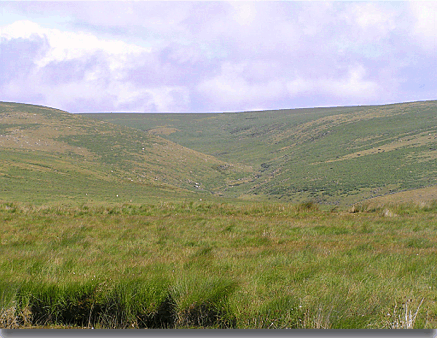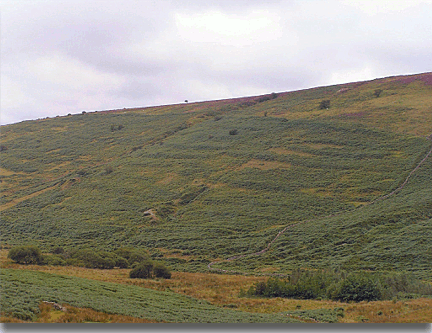
Personally speaking, the thing I hate most about modern Dartmoor is the encroachment of bracken, it is getting a serious problem for many people. Walkers hate it as on hot summer days the last thing you want to have to do is wade through shoulder high bracken and then spend hours plucking out ticks which hitched a ride as you passed through. This is not to mention the possibility of contacting Lyme’s disease. Farmers and graziers loath it as clearly it carpets out grassland and harbours ticks which also effect livestock. The spores which are released have also be proven to be carcinogenic to animals and heavy exposure can result in death. There is serious concern that the many archaeological features are being damaged by the rhizomes of the plant literally ‘eats’ into and split apart the structures of any features in their way. It is estimated that the bracken spread is around 2% per annum which when the existing cover is taken into account is quite a large rate of expansion. It has been really noticeable over the past 15 years or so how this plant has taken over huge parts of the lower moor. I was driving down past Broadaford last week and the whole of eastern ridge of Corndon now lies under a carpet of bracken and that is one very large tract of land.
Historically, bracken has been put to good use on the moor, many of the farms would harvest the bracken for use as a winter bedding for livestock, the dung- clad bedding as a fertiliser the following year and as a cover for root crops stored in underground clamps.

Cutting bracken on Piles Hill
There was ancient belief attached to bracken which said that only on Midsummer’s Eve the plant produced a blue flower. Should anyone find such a flower and collect its seeds then they would be able to become invisible, find precious metals and get their every wish granted. Centuries ago it was not unheard of to see moor folk out in the bracken seeking out the elusive ‘blue flower’ on the night of the Summer Solstice. Should one be found then the finder had to wait for it to blossom then fructify and collect the fallen seeds before midnight. It was also believed that if bracken was set alight it would induce rainfall. So firm was this belief that King Charles I demanded that no fern should be cut during one of his tours to ensure fair weather.
There is one more Dartmoor term associated with bracken and that was/is a ‘Bracken Pass’. This was a rather tongue-in-cheek expression used by a young courting couple who wished to find some privacy away from prying eyes. On a summer’s eve this would be found amongst the tall stands of bracken and to visit such a spot meant you had a ‘Bracken Pass’.
Whilst the cattle and ponies would not actually eat the bracken they would certainly tread on the young fronds which in effect weakened them sufficiently to inhibit their growth. Today livestock numbers have been reduced on the commons and therefore there are less animals to tread the developing verns. this in turn leads to unchecked spreading.

Bracken Encroachment in the Cowsic Valley
There are various means of trying to control bracken but it has now got to the stage where many of them are impractical on Dartmoor. The easiest method has to be aerial spraying and a few years ago this was tried on the slopes of Challacombe but look at it today and you would never know it had been done.

Challacombe – Aug 2006
Obviously the main problem with aerial spraying is that the chemical is not selective as to what it lands on, including other plant life, animals, water courses and any stray ramblers. The other way of using chemical control is to use a selective sprayer in the form of a weed wipe or glove, this method is heavily labour intensive. Then there is mechanical cutting, bruising or rolling which is effective in areas where there are no rocks and boulders which on Dartmoor are few and far between. In the first year this method has to be done in May/June and again in July/August and I would imagine that as this coincides with the ground nesting bird season there would be a few raised eyebrows. The other problem with this method is that it can be carried out in areas where there are antiquities. In both of the above control methods the expense is another factor, it is estimated that spraying costs between £170 and £65 an hectare, depending on the type of applicator and mechanical control is around £60. Every Dartmoor Commoners Association that has an ESA agreement is eligible to claim £100 an hectare for mechanical bracken control or £50 an acre towards the cost of spraying. Late Autumn ploughing can also prove useful especially if the torn rhizomes are exposed to frost but once again you need rock and antiquity free land to do this. The other method of stemming the ‘green tide’ of bracken is that of burning the litter in the autumn and once again mention any form of combustion and numerous ecology groups go off on one. Once again this form cannot be used in areas where there are antiquities which is fine, personally its fine to cremate a few adders etc but leave the antiquities well alone.
So it appears that a combination of the topography of the moor, costs, and numerous bodies which are all trying to protect some differing aspect of the moor has led to a stale mate. There are even some that say the many colours that bracken adds to the landscape are aesthetically pleasing? Yeah, right viewed from the comfort of a car as it crawls over the moors at 20 mph it maybe, but try thrashing your way through it, stumbling on unseen rocks and then having the privilege of removing a host of ticks and see if it’s still as ‘aesthetically pleasing’?
The bracken problem is by no means limited to Dartmoor, many other areas of the country have similar dilemmas. I was talking to someone who regularly ventures out on Bodmin Moor and he said it is becoming really difficult down there.
 Legendary Dartmoor The many aspects past and present of Dartmoor
Legendary Dartmoor The many aspects past and present of Dartmoor

This is very interesting. I wonder, at what cost would DNP place it’s honey bees, butterflies, water supply and rare plants? Spraying may be less labour intensive, but it is also indiscriminate and toxic.
I know DNP has discussed re-wilding, which would, of course, eliminate bracken for good. Once we can move past the idea of what we want our “aesthetic” moorland to be, and place a greater value on robust biodiversity, clean water and less flooding (trees are better than peat bogs here), we can embrace a safe, cheap and natural alternative bracken elimination.
I suggest you take a shower in your beloved chemicals Tim. See how it is being poisoned. I despair at such widespread ignorance. It is poison. Have you been poisoned? Do you like birds, animals, wildlife, humans, the earth? The cycles of life that sustain you? Who is paying you to write the above ignorance?
Sadly nobody is paying me for writing the ‘above ignorance’ and although I have not actually taken a shower in ‘my beloved chemicals’ I certainly have come into contact with plenty of them and am still here to tell the tale. I would be very interested to know what your ‘informed’ solution to the widely acknowledged problem of bracken infestation would be.